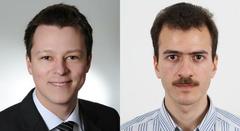URL: https://www.desy.de/news/news_search/index_eng.html
Breadcrumb Navigation
DESY News: Young scientists distinguished
News
News from the DESY research centre
Young scientists distinguished
The award of the Association of the Friends and Sponsors of DESY 2014 is shared in equal parts by Stephan Stern, DESY (CFEL) and University of Hamburg, and Tigran Kalaydzhyan, DESY (Theory) and University of Hamburg. Both are distinguished with the award including a sum of 3000 euros for their excellent PhD theses which they elaborated in the period of 1 April 2013 to 31 March 2014.
Stephan Stern, born 1982 in Magdeburg, started to study physics in 2003 at Otto von Guericke University Magdeburg where he obtained his physics diploma in 2009. He then graduated in the Coherent Imaging Division at the Center for Free-Electron Laser Science (CFEL). In his thesis titled „Controlled Molecules for X-ray Diffraction Experiments at Free-Electron Lasers“ , Stephan Stern plotted the coherent X-ray diffraction of many identical molecules by using a special procedure for the spatial alignment. In his analysis of the used 13-atoms molecule , Stern successfully deduced the size and alignment angle of the molecule in the laboratory. Thus, his thesis makes important contributions to single molecule structure determination and to possible ways of filming chemical reactions with X-ray lasers.
Tigran Kalaydzhyan,born 1987 in Yerevan, Armenia, started to study physics in 2004 at the Lomonosov Moscow State University where he obtained his diploma in theoretical physics in 2010. He then graduated in the Theory Group at DESY. The title of Tigran Kalaydzhyan’s thesis is „Quark-gluon plasma in strong magnetic fields“ and deals with the study of the properties of elementary matter at extremely high temperatures and in the presence of strong magnetic fields. It chiefly investigates the behavior of the so-called quark-gluon plasma (QGP), currently being intensively explored experimentally in collision experiments with heavy ions at the Relativistic Heavy Ion Collider (RHIC) in Brookhaven, USA und at the Large Hadron Collider (LHC) at CERN. This provides important results, among others in the so-called chiral magnetic effect, by inducing an electrical current in the quark-gluon plasma. One special feature of the thesis is the variety of applied methods, ranging from lattice gauge theory up to string theory models.




